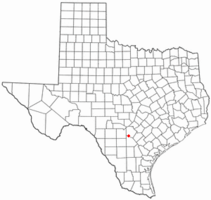Somerset, Texas facts for kids
Quick facts for kids
Somerset, Texas
|
|
|---|---|

Location of Somerset, Texas
|
|
 |
|
| Country | United States |
| State | Texas |
| County | Bexar |
| Area | |
| • Total | 2.00 sq mi (5.19 km2) |
| • Land | 2.00 sq mi (5.17 km2) |
| • Water | 0.01 sq mi (0.02 km2) |
| Elevation | 646 ft (197 m) |
| Population
(2020)
|
|
| • Total | 1,756 |
| • Density | 983.48/sq mi (379.80/km2) |
| Time zone | UTC-6 (Central (CST)) |
| • Summer (DST) | UTC-5 (CDT) |
| ZIP code |
78069
|
| Area code(s) | 830 |
| FIPS code | 48-68708 |
| GNIS feature ID | 1368603 |
| ANSI Code | 2411926 |
Somerset is a city in Bexar County, Texas, United States. It is located less than 20 miles south of Downtown San Antonio. Somerset is part of the larger San Antonio–New Braunfels area. In 2020, about 1,756 people lived there.
Contents
History of Somerset
People from Europe who spoke English started settling in this area in the early 1800s. The name "Somerset" came from a group of Baptist families. They moved from Somerset, Kentucky, and started a settlement in 1848.
The current city of Somerset began on May 25, 1909. A company called the First Townsite Company was formed. Its founders were A. M. Pyron, Carl Kurz, and Jonas A. Kerr. They built the town along the Artesian Belt Railroad.
Oil Discovery and Growth
In 1913, Carl Kurz was drilling for water. Instead, he found oil! This discovery led to a big economic boom for the area. The Somerset oilfield was huge. It stretched from Somerset all the way to Pleasanton. At that time, it was the largest shallow oilfield in the world.
Two oil refineries were built in the area. A pipeline was also built to carry the oil to San Antonio. The town grew very quickly because of this.
Boom and Decline
In 1925, only about 50 people lived in Somerset. By 1928, the population had grown to 700! The town had a bank, a hotel with ten rooms, and shops for machines and blacksmiths. A post office opened in 1920. A nearby coal mine also helped the town's economy.
During the 1920s, farmers started growing fruits and vegetables instead of cotton. In 1931, the Somerset Fruit Growers Exchange building was opened. The town did well with farming, oil, and coal.
However, things changed in the mid-1930s. The amount of oil found started to decrease. Also, the Great Depression hit, which was a time when the economy was very bad. This caused Somerset to decline. In 1931, there were 20 businesses, but by 1958, there were only eight.
Modern Somerset
In 1920, the Somerset Independent School District was created. It brought together several smaller school districts. The Somerset Police Department started in 1972. The city officially became an incorporated city in 1973. Somerset is governed by a mayor and a city council.
Geography
Somerset is a small city. It covers about 2.0 square miles (5.19 square kilometers) of land. There is almost no water area within the city limits.
Population and People
|
||||||||||||||||||||||||||||||||
Who Lives in Somerset?
The city's population was 1,756 people in 2020. Here's a look at the different groups of people living in Somerset:
| Race | Number | Percentage |
|---|---|---|
| White (NH) | 324 | 18.45% |
| Black or African American (NH) | 1 | 0.06% |
| Native American or Alaska Native (NH) | 1 | 0.06% |
| Asian (NH) | 3 | 0.17% |
| Some Other Race (NH) | 4 | 0.23% |
| Mixed/Multi-Racial (NH) | 21 | 1.2% |
| Hispanic or Latino | 1,402 | 79.84% |
| Total | 1,756 |
In 2020, there were 475 households and 353 families in Somerset. Many households had children under 18 living with them. The average household had about 3 people.
Money and Living
In 2000, the average income for a household in Somerset was about $30,268 per year. For families, the average income was around $31,875. Some people in Somerset lived below the poverty line. This means their income was not enough to cover basic needs.
Education
Students in Somerset go to schools that are part of the Somerset Independent School District.
See also
 In Spanish: Somerset (Texas) para niños
In Spanish: Somerset (Texas) para niños

